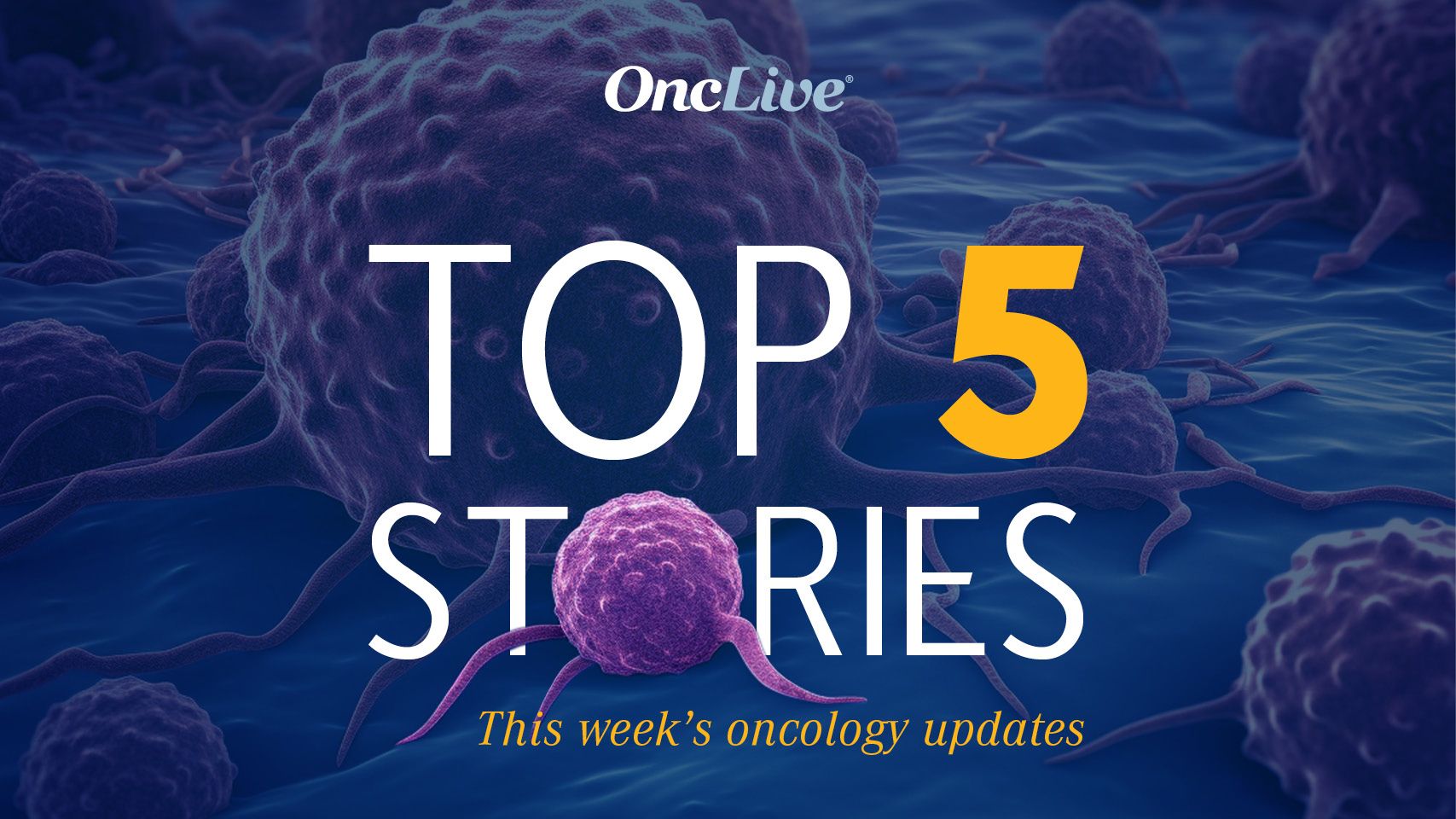Welcome to OncLive®’s OncFive!
Every week, we bring you a quick roundup of the 5 top stories from the world of oncology—ranging from pivotal regulatory decisions to key pipeline updates to expert insights on breakthroughs that are moving the needle in cancer care. This resource is designed to keep you informed on the latest updates in the space, in just a matter of minutes.
Here’s what you may have missed this week:
The FDA has approved lurbinectedin (Zepzelca) plus atezolizumab (Tecentriq) or atezolizumab and hyaluronidase-tqjs (Tecentriq Hybreza) as maintenance therapy for adult patients with extensive-stage small cell lung cancer (ES-SCLC) whose disease has not progressed following frontline induction therapy. This decision was supported by findings from the phase 3 IMforte trial (NCT05091567), which demonstrated significantly improved progression-free survival (PFS; median 5.4 vs 2.1 months; HR 0.54) and overall survival (median 13.2 vs 10.6 months; HR 0.73) with the combination vs atezolizumab alone. Among those with measurable disease, the confirmed overall response rate (ORR) was 19.4% with the lurbinectedin regimen vs 10.4% with atezolizumab monotherapy; the median duration of response was 9.0 months vs 5.6 months. Safety findings showed higher rates of adverse effects (AEs) with the combination, including nausea, anemia, fatigue, and thrombocytopenia, although most were manageable. Investigators highlighted that the combination represents a practice-changing option for eligible ES-SCLC patients with good performance status and appropriate hematologic parameters.
The FDA has accepted a supplemental biologics license application (sBLA) seeking approval of neoadjuvant fam-trastuzumab deruxtecan-nxki (T-DXd; Enhertu) followed by docetaxel, trastuzumab (Herceptin), and pertuzumab (Perjeta; THP) in high-risk, HER2-positive, stage II/III breast cancer. This submission is based on data from the phase 3 DESTINY-Breast11 trial (NCT05113251), which indicated that neoadjuvant T-DXd followed by THP significantly improved pathologic complete response (pCR) rates vs dose-dense doxorubicin and cyclophosphamide followed by THP; early trends of improved event-free survival (EFS) with the regimen were also observed. Safety was consistent with known profiles, and rates of interstitial lung disease were comparable between the arms. The regulatory agency set a Prescription Drug User Fee Act target action date of May 18, 2026, and results are expected to be presented at an upcoming medical meeting.
The FDA is reviewing a biologics license application (BLA) seeking approval of pivekimab sunirine (IMGN632), an investigational antibody-drug conjugate (ADC), for the treatment of patients with blastic plasmacytoid dendritic cell neoplasm (BPDCN). The submission is based on findings from the phase 1/2 CADENZA trial (NCT03386513), which showed a composite complete response (cCR) rate of 75% in patients with first-line de novo BPDCN and an ORR of 80%. Across all first-line patients, the cCR rate and ORR were 70% and 85%, respectively. More modest activity was observed in those with relapsed/refractory disease, at a cCR rate of 14% and ORR of 35%. Key AEs comprised peripheral edema, infusion reactions, fatigue, gastrointestinal toxicities, and neutropenia, with grade 3 or higher effects reported in 79% of patients. No cases of capillary-leak syndrome were observed.
T-DXd significantly improved invasive disease-free survival (iDFS) vs ado-trastuzumab emtansine (T-DM1; Kadcyla) in patients with HER2-positive early breast cancer and residual invasive disease after neoadjuvant therapy, according to data from a planned interim analysis of the phase 3 DESTINY-Breast05 trial (NCT04622319). Overall survival (OS) data remain immature, but the safety profile of the drug was consistent with prior studies, with no new AEs identified. This marks the second positive phase 3 trial of T-DXd in early-stage HER2-positive breast cancer following DESTINY-Breast11 (NCT05113251), which evaluated neoadjuvant T-DXd followed by THP. Results from both trials will be presented at the 2025 ESMO Congress and submitted to regulatory authorities, underscoring the ADC’s potential to optimize curative-intent therapy in high-risk HER2-positive early breast cancer.
In Q4, multiple FDA decisions could introduce new treatment options across solid tumors and hematologic malignancies. Recently, the regulatory agency approved lurbinectedin plus atezolizumab for first-line maintenance in ES-SCLC. Priority reviews are ongoing for cemiplimab-rwlc (Libtayo) in high-risk cutaneous squamous cell carcinoma, Dasynoc (XS004-dasatinib) for chronic myeloid leukemia/acute lymphoblastic leukemia, belantamab mafodotin-blmf (Blenrep)–based combinations in relapsed/refractory multiple myeloma, and more. These upcoming decisions reflect the evolving landscape of oncology treatment, with the potential to expand therapeutic options and improve patient outcomes in multiple cancer types. Sign up to access the full resource.
Honorable Mentions
- The
FDA Report: Regulatory Rundown for September spotlights 4 key FDA approvals spanning urothelial cancer, NF-1–associated inoperable plexiform neurofibromas, solid tumors, and ESR1-mutated breast cancer. - Ahead of the 2025 ESMO Congress, OncLive interviewed experts in
lung cancer andgynecologic malignancies to get their thoughts on which meeting abstracts they are most looking forward to learning more about. Sign up to access these exclusive preview articles.
